- Location and arrival
- Accommodation and travel time
- The salt lakes
- Darscho Salt Lake and Apetloner lake
- The Illmitzer bathing beach
- Bee-eater at Gols
- The Hanság
- The search for Great Bustards
- Ground squirrel at Lake Zicksee
- Black-winged stilt at Apleton
- The Thenauriegel
- The equipment
- Conclusion
- Map material of Lake Neusiedl
Lake Neusiedl is the second largest steppe lake in Europe after Lake Balaton and is known and loved for its diversity of species and wealth of birds. The majority of Lake Neusiedl
is located within Austrian territory, while a small part in the south of the lake is in Hungary.
The border crossing to Hungary is completely unproblematic and takes place without customs and personal checks, as both states are members of the Schengen Agreement. However, the
abolition of customs controls does not mean that goods can be imported and exported without restriction. It is therefore advisable to obtain more detailed information before crossing
the border if in doubt.
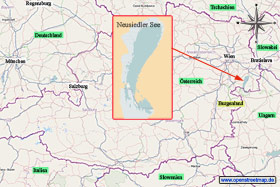
The lake is easily accessible by car and is located about 60 km southeast of Vienna. For better orientation, I am providing an overview map of Lake Neusiedl on the
left (for more details, please click on the map on the left). Although it is possible to reach the lake by train, I would only recommend it to a limited extent, as a large part of nature
photography can only be done from the car. Alternatively, one could fly to Vienna and then rent a car there. The length of the lake is approximately 36 km and at its widest point, the lake
is about 14 km wide. Especially on the west side, the relatively shallow lake (maximum depth under 2 m) has a very wide reed belt.
(zurück zum Anfang)
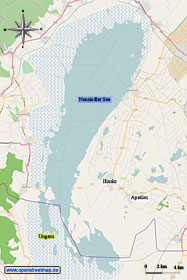
From a nature photographer's point of view, the Neusiedler See offers very few opportunities for nature photography. On the other hand, the surroundings of the lake
are all the more interesting. In particular, the Seewinkel and Hanság national parks, which have been declared UNESCO World Heritage Sites, are absolute highlights due to their unique
flora and fauna. Therefore, it is recommended to choose accommodation in these regions as well. For Seewinkel, the towns of Illmitz and Apetlon are suitable. For Hanság, the smaller
villages of Tadten and Andau are the closest address, although the infrastructure is not as well developed as in the towns of Illmitz and Apetlon. The region around Neusiedler See is very
well developed for tourism, so there are plenty of accommodations that can be conveniently booked through the websites of the respective towns.
The best time to travel for nature photography is certainly spring. While many migrating waders can be observed in March and April and most birds are in the middle of their courtship
displays, by the later part of spring, most birds are already busy with breeding. If you want to encounter bee-eaters, you should plan your stay from mid-May onwards. From June, most
butterflies and dragonflies can be found in the region. Overall, the climate around the Neusiedler See is quite warm and dry, which is why the region is also known for wine production.
Unfortunately, there is often a strong and sometimes cold wind that makes macro photography particularly difficult.
(zurück zum Anfang)
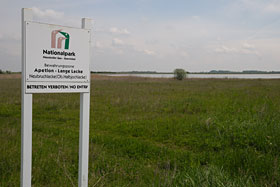
To the west of Lake Neusiedl are the
salt lakes.
The salt lakess are saltwater lakes that often have only a few centimeters of water depth. In summer, some of the Lacken frequently dry out completely, and thus, the presence of animals
depends on the water level. Many of the Lacken are surrounded by dense reed belts. Unfortunately, the photographic opportunities at the Lacken are quite limited. This is due, on the one
hand, to the fact that many of the Lacken are not freely accessible, and therefore, the distances for photography often remain too great. Furthermore, the vegetation around the Lacken is
often very dense, so that there is no clear view.
(zurück zum Anfang)
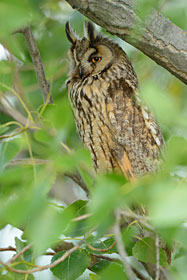
From a photographic point of view, in my opinion, the best-suited lake is the
Darscho Lacke, which is located about 3 km
north of Apetlon. You can drive all the way around the Darscho Lacke by car, and so it is possible to take pictures from the car. However, from the car, you have a quite high perspective and
you can only photograph large wading birds at eye level. However, there are also opportunities to catch birds in the reed belt. In particular, Reed Warblers are numerous there, and you just
have to spot a suitable gap ;-). In addition, you can also frequently discover Marsh Harriers, which build their nests in the reed belt, so you have a good chance of photographing these birds
of prey during their approach.
I recommend driving slowly on the way to the Apetlon bathing lake, in addition to the Darscho Lacke. Along the way, there are plenty of bushes that are often used as perches by songbirds.
Regularly, tawny owls breed at the bathing lake. The lake is a fenced natural pool, and depending on where the owl is sitting, you can photograph it from the outside or get permission from
the owner to photograph it inside the pool area. Unfortunately, it is often the case that the owl sits very high in the poplar trees, making it inaccessible from a photographic perspective.
(zurück zum Anfang)

From the town of Illmitz, a approximately 4.5 km long road leads past the Zick Lacke to the
Illmitzer bathing beach. Along a footpath that
runs parallel to the road, there are reed belts of the Lake Neusiedl on both sides. The partly dense vegetation of the reed belts offers more or less large gaps through which various heron
species can be observed and also photographed. Various species of reed warblers are also frequently seen there. In the evenings and mornings, there are the best opportunities to photograph
flying herons. There is only the option of using the paid parking lot at the bathing beach or alternatively the parking lot at the Zick Lacke.
(zurück zum Anfang)
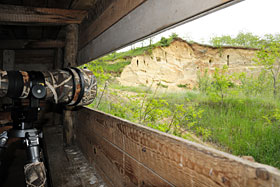
In the north of Lake Neusiedl, between the towns of "Weiden am See" and Gols, there is a breeding colony of bee-eaters. The bee-eaters can be found there from mid-May
onwards. If you drive north on the main road from the south via Podersdorf, you will come to a roundabout, where you should take the third exit towards "Weiden am See"
(see also
directions)
zu gelangen.
Follow the road for about 600m, then take a footpath towards the vineyard to reach a small
observation hut.
There are parking options behind the roundabout on the right side at the "Steckerlfisch" restaurant, or slightly further north at a snack bar on the left side of the main road. The observation
hut is unfortunately only partially suitable, as the breeding wall is quite far away. However, it also happens occasionally that the bee-eaters perch on the small trees in front of the hut and
are then within photographic distance. The hut is quite small, but you can set up a tripod there. The best photo light in spring I had in the afternoon at the observation hut.
(zurück zum Anfang)
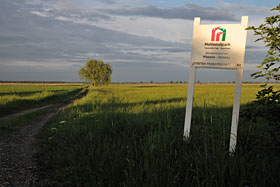
The Hansag lowland landscape is located about 25 km southeast of Lake Neusiedl and borders Hungary. The Hanság nature reserve, also called Waasen in German, can be
reached via the towns of Tadten and Andau
(
see map). The roads leading from Tadten
and Andau to the Hungarian border run parallel to each other and are about 8 km long.
In the middle of it is the conservation zone Hansag, but the way there already offers plenty of photographic opportunities. Those who drive from Andau southwards towards Hansag will discover the
sculpture park
that stretches along the road to the
Einser canal.
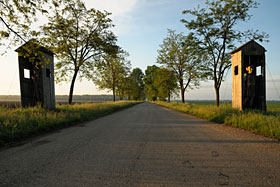
The two parallel streets can be driven in both directions, with the western one being much more interesting for photography as the variety of species is richer there. As
they are only side roads, these streets are only frequented by nature enthusiasts and farmers who use them as goods roads. It is usually no problem to park the car against the direction of travel
on the other side if you might be able to take better photos from that side. Photography is only meaningful from the car, as branching field paths are closed and setting up a camouflage tent is not
allowed throughout the Seewinkel and also in the Hansag.
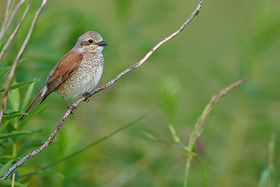
Along the two parallel streets, there are plenty of small trees and bushes where one can frequently encounter birds such as black redstarts, common redstarts, red-backed
shrikes, pied wagtails, gray partridges, and skylarks. On a section of the road leading from Tadten to Hansag, there is a small
reed bed where one can more frequently photograph
reed warblers from the car.
Otherwise, in the area, one can frequently observe harriers hunting. Unfortunately, the extremely shy great bustards can usually only be observed from very far away. For this purpose, the
observation tower located directly on the border at the Einser
Canal is recommended. A few steps away from the observation tower is the historic
Andau Bridge, which is already located on Hungarian territory. During the Hungarian
Uprising of 1956, around 70,000 people fled across the then very small bridge to Austria to escape the Red Army.
(zurück zum Anfang)
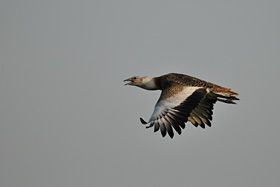
As mentioned before, encountering great bustards is extremely rare, at least if one takes photo distances as a standard and wants to take a high-quality picture. The escape
distance of great bustards is between 400m to 600m. Fortunately, a great bustard is quite large (up to 105cm in height and up to 16kg in weight). However, to be able to photograph them properly,
distances of around 50m are needed, which are generally not achievable. Female great bustards are only half the size and one-third the weight of males. Unfortunately, the population of great
bustards is declining and highly endangered. In May 2011, I was lucky enough to have a male great bustard fly over me in Hansag and I was able to take these aerial shots with a tripod that I had
set up beforehand.
(zurück zum Anfang)
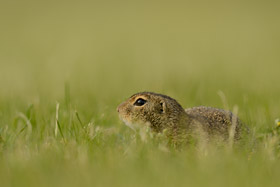
If you want to take pictures of ground squirrels (Ziesel) easily and without much effort, the camping site at Lake Zicksee is the perfect place to go. The campsite is
located west of the town of Sankt Andrä am Zicksee and is directly on the lake
(
see map). The ground squirrels scurry around
on a meadow directly next to the administration building. The administration building should also be the first point of contact for photographers because the campsite is private property.
Permission to take photos of the ground squirrels on the property should therefore be obtained from the administration and is usually gladly granted upon friendly requests.
Of course, this type of photography is only very limitedly considered nature photography because the animals are accustomed to humans and no longer exhibit their natural fleeing behavior.
However, they are still not pets, and many animals keep a respectful distance from humans. By the way, it is also very possible to photograph the animals without luring them in, but that
requires a little more patience. Personally, I found that approach more enjoyable.
(zurück zum Anfang)
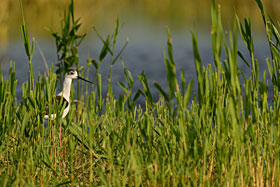
Southwest of Aplton is the National Park Administration
(
see map) and across the street is a wetland
where, among other things, Black-winged stilts breed. The photo distance to the stilts is quite a distance, but the birds are quite large when they stand up. Unfortunately, it is not possible
to photograph the stilts at eye level on site, but those who want to photograph the birds in the context of the surrounding landscape will find a very beautiful environment there. Especially
in the morning, a detour to the stilts is worthwhile, provided they continue to breed there in the coming years. During my last visit in June 2020, I could not find any Black-winged stilts
at the spot, but the spring was extremely dry and the area was practically dried out.
(zurück zum Anfang)
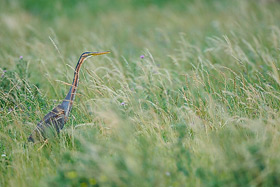
Surrounding the National Park administration are various meadow areas, and since the area is very close to the reed bed of Lake Neusiedl, you can repeatedly encounter
various wading birds such as grey herons, white storks, and with some luck, even purple herons. In addition, the meadows are also a popular hunting ground for marsh harriers.
(zurück zum Anfang)

The Thenauriegel is part of the Thenau nature reserve and is located south of the small town of Breitenbrunn in the north of Lake Neusiedl
see map).
At the foot of the Leitha Mountains, whose highest peak is 484 m, the Thenau nature reserve begins, which is very well suited for macro photography.
You are not allowed to drive all the way up to the Thenauriegel by car and have to walk the last few hundred meters. In addition, there is a strict path requirement in the nature reserve, but
there are also numerous opportunities for macro photography on the edge of the area, embedded in vineyards. You can encounter various lizard species such as fence and green lizards, as well
as various insect and plant species. So far, I haven't spent much time in the Thenauriegel, but I will definitely make up for it in the future.
(zurück zum Anfang)

Most photos around Lake Neusiedl are taken from the car, so a beanbag as a lens support should definitely be brought along. As with bird photography, it is recommended to bring as much focal
length as possible, at least 500mm - 600mm, which can be extended if necessary with a converter. For the observation hide at the bee-eaters and at the reed belt at Illmitzer Strandbad, I would
recommend bringing a tripod. A camouflage tent can be dispensed with, as it cannot be set up within the national park anyway. For macro photography, which I myself have not yet done at Lake
Neusiedl, a macro lens should not be missing. Even if landscape photography in the fauna and flora may only be a marginal area for most people, in my opinion, it is still worth taking along
smaller focal lengths.
(zurück zum Anfang)
A visit to Lake Neusiedl is definitely worthwhile. On a relatively manageable area, there is a very high biodiversity. Although the national park is certainly not a petting zoo, due to the
high density of animals, you have very good chances of getting many good shots. In addition to bird photography, a visit to the Leitha Mountains is certainly worthwhile for fans of
macro photography.
(zurück zum Anfang)
You can download maps of the Neusiedler See region here. To view and print them, you will need an Acrobat Reader. The maps are intended for rough orientation. I also recommend purchasing
a map of the Neusiedler See in a scale of 1:50,000 for further reference.
 Map of Lake Neusiedl
Map of Lake Neusiedl
written: July 2010, (author: Olaf Juergens)
updated: June 2020
 print version
print version


















